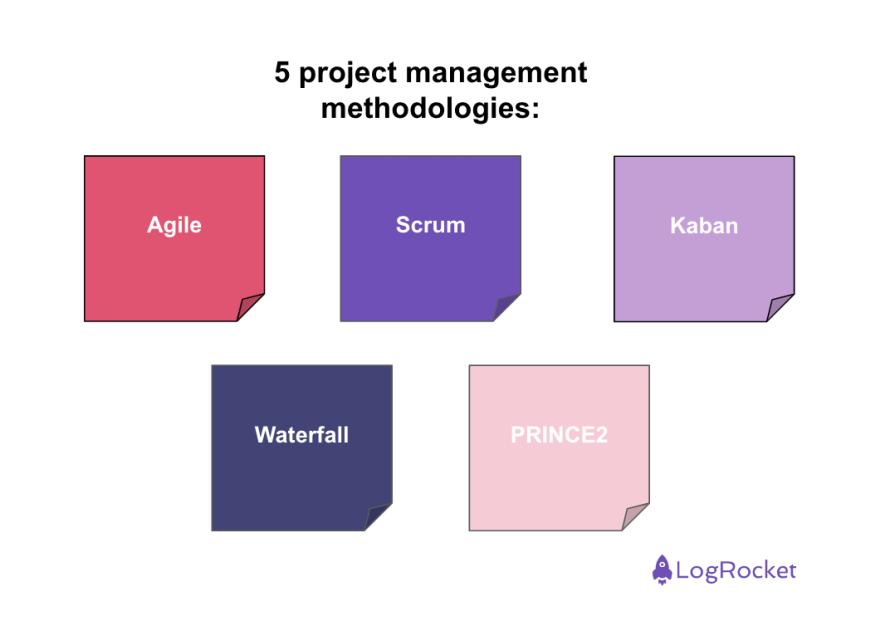Project management methodologies are different types of frameworks that product teams can use to manage end-to-end development. These methodologies serve as a template for navigating complex projects. In this article, you’ll learn about some of the most common methodologies, as well as how to go about selecting the best one for your project.

Project management methodologies have changed over time to help software development teams with the necessary tools, processes, and frameworks to guide product development. There are five common methodologies that each cater to different teams, industries, and project requirements:

As a PM, you probably encounter agile pretty often. It focuses on building software in an iterative approach through continuous collaboration between cross-functional teams such as engineering, design, marketing, sales, customer service, and even higher management.
Agile takes its direction from the Agile Manifesto, a set of guidelines created by a group of engineers in 2001. It has 12 principles that can be used as a yardstick for software product development. The main goal of agile is to enable teams to respond to unplanned market changes and customer requirements.
Example: You might use agile for the development of a mobile app. App development is a complex process and requires flexibility and response to customer requirements. The project in most cases is iterative providing space for regular adjustments based on feedback.
Scrum is a specific agile framework that helps teams divide a complex project into smaller deliverable chunks called sprints. These sprints are usually two weeks long. It emphasizes close collaboration, transparency, and delivering a shippable small feature incrementally.
It’s the most popular agile framework. Below are some key elements of Scrum:
Example: The scrum approach might work well for the redesigning of a return feature on an eCommerce website. Such a task requires close collaboration between engineering, design, customer service, and logistics. Scrum allows for a quick and short feedback loop between these teams and regular feedback.
Kanban is a simple visual representation tool that allows teams to view the state of the product at any given point in time. The four states are defined as:
Work items are represented visually by a sticky note or a box depending on whether the team meets in-person or virtually. These are then moved according to the state they’re in. Kaban is still one of the preferred choices for product development because of its ease of use.
Example: Kaban could assist a content marketing campaign for a cake shop. It would make sense because the tasks have different priorities and need to be completed continuously. The visual kanban flow with to-do, in-progress, testing, and production would be ideal for managing this campaign.
Waterfall is one of the traditional project management methodologies that’s based on delivering output sequentially. This is the opposite of agile, where the output is delivered in a continuous environment. The six non-overlapping and distinct phases include:
Because these phases are linear, the waterfall model isn’t flexible and doesn’t cater to the changing market conditions and customer requirements. As a result, most industries have shifted to agile.
Example: Waterfall could work for the construction of a bridge. This project would ideally have all the requirements finalized right at the start, such as where the bridge should be, its height, the budget, how much load it would bear, etc. In this case, the scope is well-defined and tasks follow a clear sequence such as planning, design, construction, and inspection.
PRINCE2 (PRojects IN Controlled Environments) was developed by the UK government and is now widely adopted globally in both public and private sectors. Much like other methodologies, it provides a structured approach to building products. Seven principles guide this particular project management methodology:
PRINCE2 also has a certification that helps project managers learn all the bits and pieces of the methodology.
Example: PRINCE2 would be effective for the Implementation of an ERP (Enterprise Resource Planning). This is a large-scale project and will require a bunch of clear processes and roles. PRINCE2 is ideal for such scenarios.
In my decade of product management experience, I have had many opportunities to select a project management methodology. Below, I’ve summarized a few important parameters to consider before choosing the right project management methodology.
This includes what needs to be achieved, at what time, and the complexity. Simple smaller projects that don’t require a lot of iterations might be suited to waterfall, while complex projects that require continuous collaboration and improvements would require scrum. So understanding the project requirements is the first step.
Post-pandemic a lot of teams started working remotely. In a world where everyone is distributed, it’s important to double down on project management. A small co-located team might be comfortable with scrum since it emphasizes close-knit collaboration, while large distributed teams might be comfortable with waterfall or a hybrid approach of scrum and kanban.
Some team members might be well-versed in agile, while some might have deep experience in PRINCE2. It’s important to understand the strengths and weaknesses of the team as a whole before deciding.
It’s important to talk with all the relevant stakeholders and understand what they are comfortable with. Gather input from engineering, design, marketing, sales, customer service, higher management, and all other stakeholders/teams that are directly or indirectly impacted by the project.
Once decided on, I recommend you pilot the methodology before pushing it live. Maybe take two weeks and start using it as your team would do in real life. Evaluate how the team feels, the project progress, and the challenges. This will give you a much clearer picture.
Transitioning between two different project management methodologies can be a very difficult and complex task, but here’s a few tips for a smooth transition.
Why does the transition need to happen? What does the current project management methodology lack that can be fulfilled by the other project management methodology? How much cost would the company bear if the transition happens? Understand the rationale behind the transition and evaluate the possibilities.
If you agree to transition, make sure that the concerned teams get adequate training. Invest in the tools and bring external trainers if needed.
Before implementing the new methodology, make sure to do a short pilot and understand the strengths and weaknesses of the methodology. Does it help overcome the problems originally stated? If not, go back to the whiteboard and understand the reasoning.
Once the new methodology is implemented, monitor it closely. Foster open communication and take feedback from the respected team members. Adjust if needed and celebrate the success after small wins.
In my experience, project management methodologies provide a framework to understand the project and take it to the finish line. They served as a backbone of a project providing a clear set of guidelines. While agile and scrum have been the preferred choices, I’m keen to see what new project management methodologies appear in the next 10 years.
One thing I do believe though is that new project management methodologies need to be flexible and agile and help the modern teams equipped with AI and other technological advancements.
Featured image source: IconScout

LogRocket identifies friction points in the user experience so you can make informed decisions about product and design changes that must happen to hit your goals.
With LogRocket, you can understand the scope of the issues affecting your product and prioritize the changes that need to be made. LogRocket simplifies workflows by allowing Engineering, Product, UX, and Design teams to work from the same data as you, eliminating any confusion about what needs to be done.
Get your teams on the same page — try LogRocket today.

Most teams fail at autonomy. Learn how clear rules help product teams move faster without micromanagement.

A practical framework for PMs to use AI in ideation without sacrificing judgment, strategy, or decision quality.

A practical five minute revenue estimation method to help product managers compare ideas, drop low impact features, and prioritize smarter.

A practical guide for PMs who want to stop being bottlenecks, delegate smarter, and lead teams effectively with a clear ownership framework.